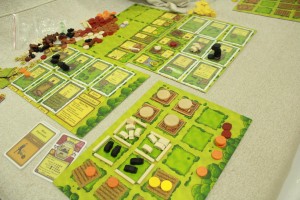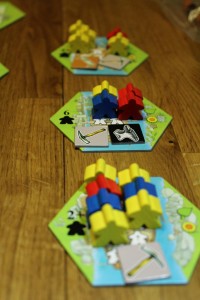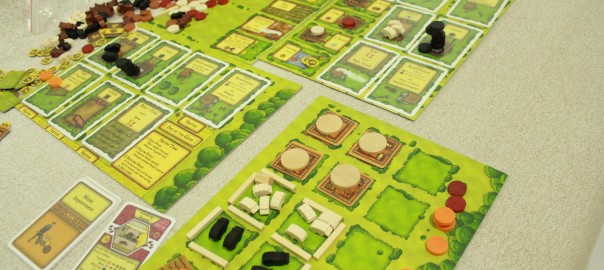I haven’t written a full designer diary on a game since my first game, Chaos & Alchemy. I think it’s time I started up again.
I’m in the early playtesting stages right now for a game that I’m tentatively calling Mansion Builder. It’s going well enough that I think it’s worth writing about. So here we go!
Theme Idea: Building… something
The original idea for Mansion Builder came from reflecting on the idea that players like building something during the course of a game. You build a farm and a resource engine in Agricola. You build a rail network in Ticket to Ride. You build a plot quest engine in Lords of Waterdeep. You build a laboratory in Chaos & Alchemy.

Building stuff is fun and rewarding. So why not build a literal building? I decided I wanted to make a game about building houses, with a comedic touch. I wanted players to build ridiculous mansions with over-the-top features like solid gold bathtubs and heliports.
I could envision this game with some cute cartoon illustrations of crazy home improvements on cards. It was a concept that got me excited.
Mechanic idea: Different types of workers
When I first started pondering Mansion Builder, I had been playing a lot of Keyflower. This is a game that features several different colors of meeples and uses them as a type of currency.

I started thinking that I could have different colored meeples in Mansion Builder, representing different worker skills. I could have tons of specialties like masons, electricians, carpenters, plumbers, drywall hangers, painters, landscapers, etc. I could instead have a few basic classes of workers: Regular, skilled, master. And then I could have various improvements that had costs of materials and also costs of labor, with the players bidding for all of these things.
I quickly realized, before I even got to the point of putting anything on paper, that this was way more complicated than I wanted Mansion Builder to be.
Mechanic idea: Pooled auction
In thinking about the varied workers idea, I started thinking about how players would get those workers, and I liked the idea of some sort of auction. Once I abandoned the variety of workers, I decided I wanted to focus on the auction mechanism.
Players would now bid on various improvements that were offered by contractors. This would be done in a pooled auction.
A pooled auction is a rather uncommon type of auction. Bidders all bid simultaneously. Each bidder pays however much he or she bid. The highest bidder gets first pick of the items that are for sale. The second highest bidder gets second pick, and so on. Everyone gets something, and the players are effectively bidding on choice order.
I was familiar with this type of auction from my days as an economist back in graduate school. As a matter of fact, my lone academic publication in economics was a paper I co-authored with one of my professors, Tim Salmon. He did most of the work, honestly; I mainly built and ran the experiment software that we used to put undergraduates through various auction games, while Tim did the theoretical work and the actual writing. If you’re looking for some heavy academic writing on the topic, you can find the paper here.

How it would work
Mansion Builder will proceed in a series of rounds. In each round, there are a number of improvement cards up for auction.
Players will bid in a pooled auction, with the winner getting first choice of the improvements, second place getting second choice, and so on.
Any improvement that is not selected is “sweetened” for the next round (probably putting money on it), and then new improvements are revealed.
At some point, players will be able to sell their improvements to various buyers who want various combinations of improvements. If you sell a buyer a house that has all of the improvements the buyer wants, you get bonus money.
The player with the most money at the end of the game would win.
Next steps
I’ve described the initial playtest version of Mansion Builder above, but I can tell you that there were some issues I had to deal with right away. How will the physical realities of the auction work? Is having the winner determined by money a problem? (Hint: Yes, it is.) How exactly do these buyer cards work?
I’ll leave those questions for the next entry in my Design Diary: Mansion Builder series.
And shameless plug time: My kid-friendly card game, Otters, is still on Kickstarter at this very moment. It’s fully funded, so you can get a copy if you want one! The campaign runs through February 27, 2014.
Michael Iachini
@ClayCrucible on Twitter
